TL;DR: Which Tray.io alternatives to explore in 2024
| Coupler.io | Jitterbit | Integrately | Ninjacat.io | Unito.io | |
|---|---|---|---|---|---|
| Pricing | Starts at $64 | On request | Starts at $29.99 | On request | Starts at $124 |
| Data transformation | ✅ | ✅ | ✅ | ⛔ | ✅ |
| Data blending from multiple data sources | ✅ | ✅ | ✅ | ⛔ | ✅ |
| Custom schedule for automatic data refresh | ✅ | ⛔ | ⛔ | ⛔ | ✅ |
| New sources and features on request | ✅ | ⛔ | ⛔ | ⛔ | ⛔ |
| White label ready-to-use report templates | ✅ | ⛔ | ✅ | ✅ | ⛔ |
| G2/Capterra reviews | 4.8/5 | 4.6/4.4 | 4.7/4.1 | 4.1/4.4 | 4.5/4.5 |
| Affiliate program | 25% recurrent lifetime commission | Undisclosed benefits | Discounts and rewards provided after submissions | $100 for a qualified lead + $500 if that lead signs for 1-year subscription | Amazon gift card |
Best Tray.io alternatives in 2024
1. Coupler.io
Coupler.io is an automation and analytics platform designed to pull large data sets into dashboards and automate reporting.
The platform consolidates data from multiple sources to a single access point. This helps users make better data-based decisions without having to juggle between various sources of data.
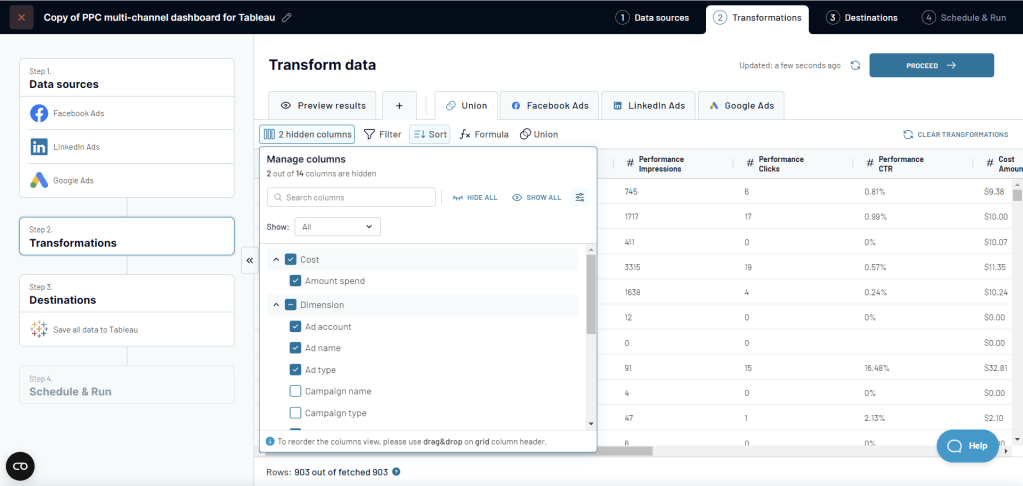
Coupler is a great Tray.io alternative because it supports the integration of all the largest data sources for marketing, finance, eCommerce, sales, and agency operations.
Companies that would usually need to hire an analyst team can now process all the data automatically. The no-code solution enables teams to reach a new level of analysis maturity.
Let’s identify the biggest benefits of Coupler.
Coupler.io pros
- White-label ready-to-use dashboard templates. Pre-designed dashboard layouts that are customizable and ready for immediate use without having to modify them.
- 10+ destinations supported. Users can export data from their apps to the most popular destinations, including Looker Studio, Google Sheets, Excel, BigQuery, Power BI, Monday.com, and others.
- All sources and destinations are available on every subscription plan. Regardless of their subscription plan, all users can access all sources and send data to every destination.
- Easy data consolidation with no programming skills required. Coupler was built for non-technical users, so anyone without coding experience can create connections between different sources and pull reports.
- Affordable pricing for SMBs and startups. Starting from $49/mo (for annual billing), there is no entry bar for teams that want to introduce a data-driven approach to decision-making. In addition, you can start for free without your credit card required.
- Data export is available from over 60 apps. The platform lets users pull data from every core source, including Microsoft, Google Workspace, Airtable, Meta, Jira, Salesforce, etc.
- Automatization for data refreshing. The solution refreshes data every 15 minutes, which eliminates the need for users to re-create reports. This effectively eliminates all manual labor from the reporting process.
- Superior versatility. Coupler is designed for any team that needs help to organize its data, automate reporting, and improve its decision-making processes. This can be any business, from startups to SMEs to enterprise-level organizations with huge data pools.
Coupler.io pricing
You can start Coupler.io for free and then decide on the pricing plan to proceed with:
- Starter at $64/mo; ideal for smaller teams who rely on no-code functionalities, supports two users.
- Squad at $132/mo; bigger teams with larger import sizes, advanced functionality, and guided onboarding, supports five users.
- Business at $332/mo; all functionalities with 15-minute data refreshing, extended onboarding time, and 10,000 data runs per month, with unlimited users.
- Enterprise for organizations with exceedingly large volumes of data and custom integration requirements.
Coupler.io integrations overview
With over 500 integrations available, the platform runs data from any CRM, marketing, finance, or core applications into dashboards or data warehouses. As a no-code solution, users receive support with the initial integration of their core apps and additional onboarding for Squad, Business, and Enterprise users.
Coupler can integrate apps across these categories:
- CRM systems (ActiveCampaign, HubSpot, Pipedrive, and others)
- E-commerce (Shopify, WooCommerce)
- Marketing (Facebook Ads, Instagram Ads, YouTube, Google Analytics 4, and others)
- Finance (Stripe, Xero, and QuickBooks)
- Project Management (Airtable, Asana, ClickUp, Trello, Jira, and others)
Time Tracking (Clockify, TimeTonic, Harvest) - Email (ActiveCampaign, Calendly, Klaviyo, and Mailchimp)
Core apps like Google Sheets also have additional support as a Google Sheets add-on. Users who use Google Sheets as a destination for their data can install the add-on and manage automated data flows directly from their spreadsheets.
Coupler.io limitations
- Most dashboard templates are in Looker Studio: Coupler.io develops templates for other destinations but Looker Studio keeps well up here.
- Relatively short guided onboarding time. Despite being a no-code, easy-to-master tool, 30 and 60 minutes of guided onboarding for Squad and Business users might not be enough for all users.
Note: Coupler.io is a worthy alternative to Tray.io and other data integration and automation solutions. Check our related articles:
2. Jitterbit.com
Another Tray.io competitor, Jitterbit’s Harmony iPaaS, is a low-code integration platform that enables easy and secure data transfers between multiple sources.
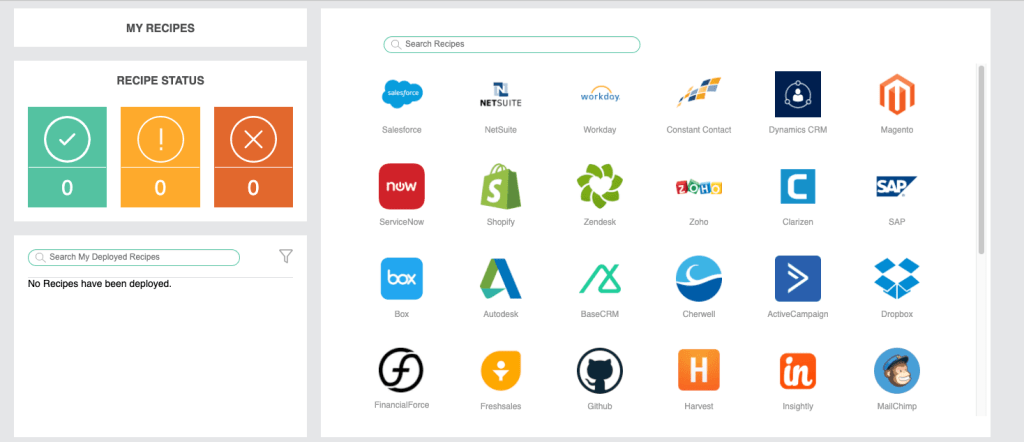
It helps companies connect their SaaS tools, cloud, and on-premise apps and pave the way for a connected digital journey.
Jitterbit pros
- Easy for less complex data integration between multiple platforms and systems. Most of the configuration can be done through point-and-click workflows and users have assisted integration throughout the cycle.
- Automation of purchasing processes. System-wide automation of order-to-cash cycles, from receiving purchase orders to realizing payments.
- Accelerated employee expense management. It provides a 360-degree view of expenses and faster employee reimbursement.
- Superior workflow automation for Customer Experience, HR, IT, and Commerce operations. Harmony can introduce a new level of workflow automation to improve efficiencies across different departments.
Jitterbit pricing
Jitterbit’s pricing is undisclosed; the yearly costs are custom and based on specific business requirements.
There are three service tiers available:
- Standard; 2-3 connectors available, 2 virtual environments, and 2 private agents assigned. The average response rate is 48 hours.
- Professional; 5 connectors, 99 virtual environments, and 2 private agents assigned. The average response rate is 24 hours.
- Enterprise; 8 or more connectors, 99 virtual environments, and 4 private agents assigned. The average response rate is 6 hours.
Jitterbit integrations overview
Jitterbit integration relies on pre-built connectors and templates that are made for NetSuite integration so that the configuration process is simplified.
With Jitterbit’s connectors, multidirectional data synchronization enables seamless flow between NetSuite and other integrated systems.
These are the categories for supported app integrations:
- Data (Amazon S3, Amazon Redshift, Database, and others)
- eCommerce (Amazon Marketplace, BigCommerce, eBay, and others)
- CRM (Salesforce, HubSpot, SugarCRM, and others)
- Software development (GitHub, GitLab, Jira, and others)
- Communications (Microsoft Outlook, Gmail, Trello, and others)
- Marketing (Google Analytics, Google Workspace, Microsoft Advertising, and others)
- Project Management (Microsoft Teams, Slack, Workday, and others)
- Finance (Stripe)
Jitterbit limitations
- A limited number of connectors. Compared to Tray.io or Coupler.io, Jitterbit doesn’t have nearly as many connectors which has an impact on integration efficiency.
- The unclear distinction between tiers of service. Since service tiers vary mostly on response rates and numbers of assigned agents, it’s difficult to determine which is suited best for a specific business, startup, or enterprise. The lack of a visible pricing scheme also makes planning harder.
- Lengthy response time. If you’re a standard user with less complex integration needs, 48 hours of ticket resolution time might be too long.
3. Integrately.com
Intregrately is an integration platform that enables users to automate their manual tasks with a single-click mechanism.
The platform is made for business owners and startups who want to automate their processes early during their initial growth.

Currently, the platform can integrate over 1,100 applications using pre-made integration templates.
Integrately’s pros
- One-click integration. Users integrate core apps using a simple one-click mechanism.
- Unlimited Free trial. There is a free version of the platform available that teams can use indefinitely, but it does have some functionality limitations.
- Extremely affordable pricing. When it comes to pricing, Integrately doesn’t have an entry barrier, and any SME or startup can try the solution.
- Flexibility for integration. Users can integrate well over 1,000 different integrations, which makes the solution very flexible for most users.
Integrately.com integration overview
The one-click integration is what makes this solution stand out from dozens of integration platform vendors.
Intergately is built for no-code integrations where users with no programming proficiency can scroll down the list of integrations and manually integrate by clicking a button.
Users can also add integrations on top of integrations, connecting several core apps into the same process. For instance, you can connect Facebook Lead Ads with Gmail and Google Sheets and have your leads from different sources load into a separate Drive Sheet.
Here are the app categories for Integrately’s platform:
CRM (HubSpot, Pipedrive, and others)
- Website & SEO (WordPress, Google Analytics 4 and Webflow)
- Communications (Zoom, Gmail, Microsoft Outlook, Discord, and others)
- Project management (Asana, ClickUp, Trello, and others)
- Calendar (Calendly, Airtable, Google Calendar)
- Messages (SendFox, GetResponse, ClickSend SMS, and others)
- eCommerce (Shopify and WooCommerce)
- Social media (Instagram, Facebook, Twitter, YouTube, and others)
- Finance (Stripe)
Integrately’s pricing
Integrately has five service tiers:
- Free; unlimited use, with up to 5 automations but no premium app integrations, 100 tasks.
- Starter; monthly billing at $29.99, 20 automations with 3 premium app integrations, 2000 tasks.
- Professional; monthly billing at $49, unlimited automations and premium app integrations, unlimited tasks, 1 user.
- Growth; monthly billing at $124, unlimited automations and premium integrations, 30,000 tasks, unlimited users.
- Business; monthly billing at $299, unlimited automations and premium integrations, 150,000 tasks, unlimited users.
Regarding pricing, Integrately is very affordable and the Free version (that can be used indefinitely) is useful for testing the platform without a time limit.
This makes it a favorable choice for small businesses with no expertise in integration.
Integrately’s limitations
- Manual integration. While the solution relies on a one-click integration, having to integrate multiple dozens of different apps is demanding. If important functions aren’t working properly, reporting and data analysis will suffer. This can be avoided only with an integration platform with strong core app integration.
- Unlimited premium app integrations only at the Professional tier. If your company needs more than three premium apps (for instance, Gmail, Salesforce, Hubspot, and Calendly), the more affordable tiers are of no use to you.
- Time-consuming creation of workflows. Creating workflows for manually added integrations can be extremely time-consuming. A solution that automatically pulls and organizes data from integrated apps will save time and enable adding more data to decision-making.
4. NinjaCat.io
NinjaCat is a digital marketing performance management platform that helps marketers consolidate campaign data and reach automated reporting.
The platform can integrate with over 150 marketing channels and consolidate their valuable data into a single source of truth.
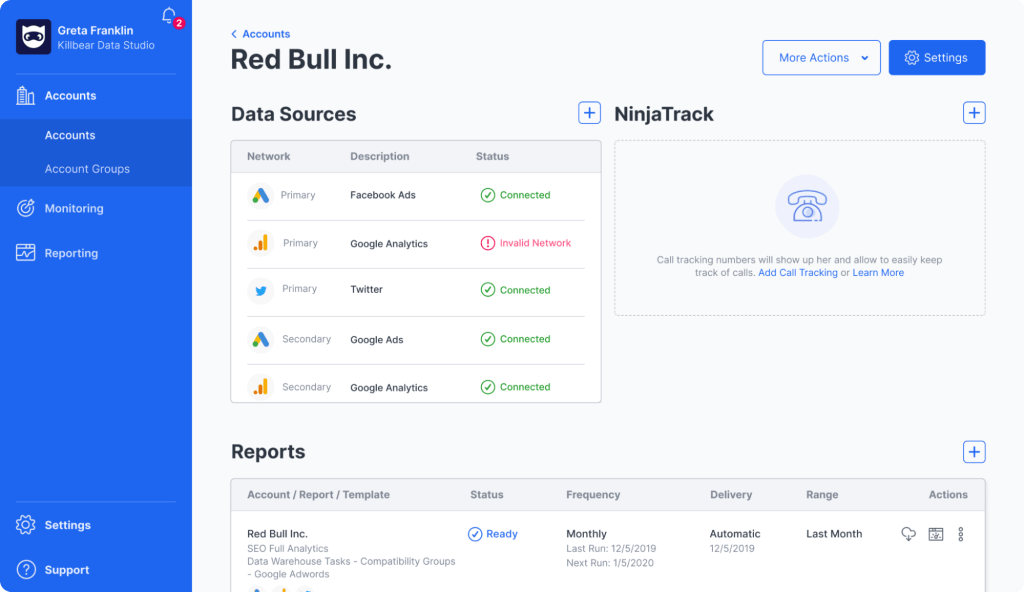
In addition to visualizing all the marketing data, reports generated from the platform can pull images and text from core marketing apps to provide a complete context.
NinjaCat.io pros
- Impressive data pipeline from different sources. Users can gather marketing data from 150 different apps and sources.
- Managed data warehouses. Data can be stored within NinjaCat’s data cloud.
- Ready to use automated reporting templates. Users can access pre-made templates for their automation and reporting tasks.
- AI Copilot. The platform also automatically connects its AI copilot, which is powered by Natural Language Processing (NLP) similar to ChatGTP. The AI copilot is a virtual assistant for data analysis and support.
NinjaCat’s integration overview
NinjaCat has out-of-the-box integrations with over 150 CRM, social media, PPC, project management, and customer intelligence tools. However, users need to manually integrate all the sources they need, and integration functionality varies.
Some on G2 and GetApp shared their negative experiences with difficult integrations for Yelp, Twitter, Pinterest, and Yext, respectively.
NinjaCat can integrate apps in the following categories:
- CRM systems (Salesforce and Cirrus Insight)
- Call tracking & chat (NinjaTrack, Infinity, Invoca, Callbox, and others)
- Customer intelligence (Comscore, Brandwatch, Infutor, and others)
- eCommerce (Amazon Ads, Shopify, and Amazon MWS)
- SEO and listing management (Google My Business, Yext, Waze, Yelp, SEOmonitor, and others)
- Project management (Monday.com)
- Social Media (Facebook, Twitter, Instagram, YouTube and others)
- Marketing, automation & fulfillment (HubSpot, Marketo, AdButler, Listrak, Fluency, and others)
- Data (Snowflake, Google Sheets, Amazon S3, Amazon AWS, Microsoft SQL Server, and others)
Ninjacat.io pricing
NinjaCat’s pricing is undisclosed.
Unlike other vendors from this list, the platform doesn’t offer tiers with scaled functionalities.
It is most likely that pricing varies by the number of connectors and the complexity of the client’s tech stack.
According to an article from Porter Metrics, the pricing varies between $999 to $2599.
Software Guest reported that the pricing is $3000 per contract.
NinjaCat’s limitations
There are several drawbacks to using NinjaCat that have to be considered:
- It’s one of the least affordable solutions on the list. If you’re a startup or a SME that’s looking to introduce automated reporting, this will not be the most cost-efficient option.
- Use cases are limited to marketing. Unlike Coupler or Tray, the solution doesn’t offer a holistic approach to all core apps like finance or sales.
- Limited functionality. Several users from G2 reported that NinjaCat cannot do calculations across data sources or across time periods. The platform cannot support more than one GA event displayed in a single widget (table).
- Limited file formatting. Users are required to reformat files manually and add manual calculations, which is extremely time-consuming.
5. Unito.io
Unito is a data integration platform that consolidates marketing, project management, CRM, and software development data. Users can automate their workflows and scale reporting to reduce hours and increase efficiency.
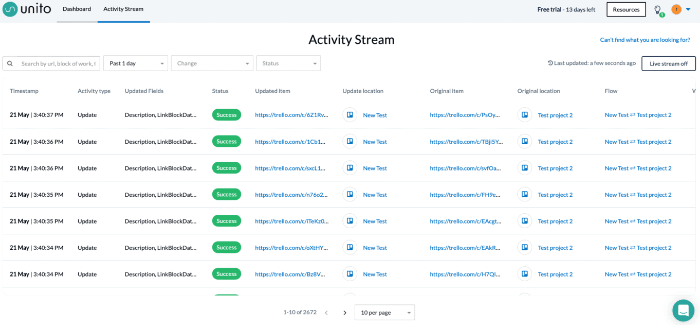
Unito’s advantage is that it can track cross-app user data. This allows companies to see how efficient their teams are with the platform and the time saved.
Unito.io pros
- Two-way data flows between the platform and integrated apps. Data can be transferred from the platform to the integrated apps and vice versa.
- Quick setup. Apps can be integrated between 5-10 minutes, according to the documentation.
- Customizable workflows with 16 different event triggers. The system offers users a selection of 16 different event triggers to choose from within an integrated app-
- 49 different integrations with critical apps. Unito currently supports 49 integrations that are considered standard, with new integrations being developed.
Unito.io pricing
Unito offers a 14-day free trial with full functionality. After the trial expires, users need to subscribe if they want to access their workflows.
There are four tiers with a 20% discount on annual billing, but the pricing of each tier varies on the number of items in sync:
- Basic at $124/mo; 1250 items in sync, 15-minute updates, basic fields, and self-serve support.
- Pro at $374/mo; 2500 items in sync, 5-minute updates, sub items, checklists, and custom fields, enabled chat and email support.
- Business at $961/mo; 6000 items in sync, unlimited tool combinations, live CSM coaching, and updates in real-time.
- Enterprise has custom pricing; tailored contracts, advanced security, unlimited workspaces and tool combinations, custom integrations, and reporting.
Unito.io integrations overview
The platform supports a wide range of apps that users can integrate and allows for one-way and two-way synchronization. Changes made in one tool are automatically updated in the other connected tools, and the data is updated regardless of the app being used.
Here are the app categories that can be integrated with the Unito platform:
- CRM (HubSpot, Pipedrive, and Salesforce)
- Database management (MySQL, PostgreSQL, and Snowflake)
- Marketing automation (Eloqua, HubSpot, and Mailchimp)
- Project management (Asana, ClickUp, Trello, and others)
- Software development (GitHub, GitLab, Jira, and others)
- Calendar (MySQL, PostgreSQL, and Snowflake)
- Support (Intercom, Jira Service Management, and Zandesk)
- Messaging (Slack)
Users integrate tools themselves by choosing the flow directions from the list of synced tools, setting rules for event triggers, and creating field maps.
While Unito is a no-code solution, setting rules for triggers requires applying some programming logic, as it relies on If, And, and Then loops.
Unito.io limitations
- Lack of integrations that are considered standard. According to the platform’s resource library, the connectors for Facebook Insights, Google Forms, MySQL, and Marketo are still in development.
- Many key app integrations are per request. Integrations with Microsoft Excel, Salesforce, Snowflake, ServiceNow, PostgreSQL, and Eloqua are per request only.
- Unlimited tool combinations come only at the Professional and Enterprise tiers. Otherwise, users can sync 1 tool with every other. This means that if you want to automate reporting from 3 different tools, such as Google Sheets, Hubspot, and Instagram, you’ll be able to do that only from the $769 /mo Professional tier, or more.
- Higher upfront integration costs. The pricing can be an entry barrier for many SMEs and startups who are still scaling.
Do you need to search for Tray.io alternatives?
Integrating more apps into your tech stack should enable your team to do more tasks, automate and optimize the workflow, and increase productivity.
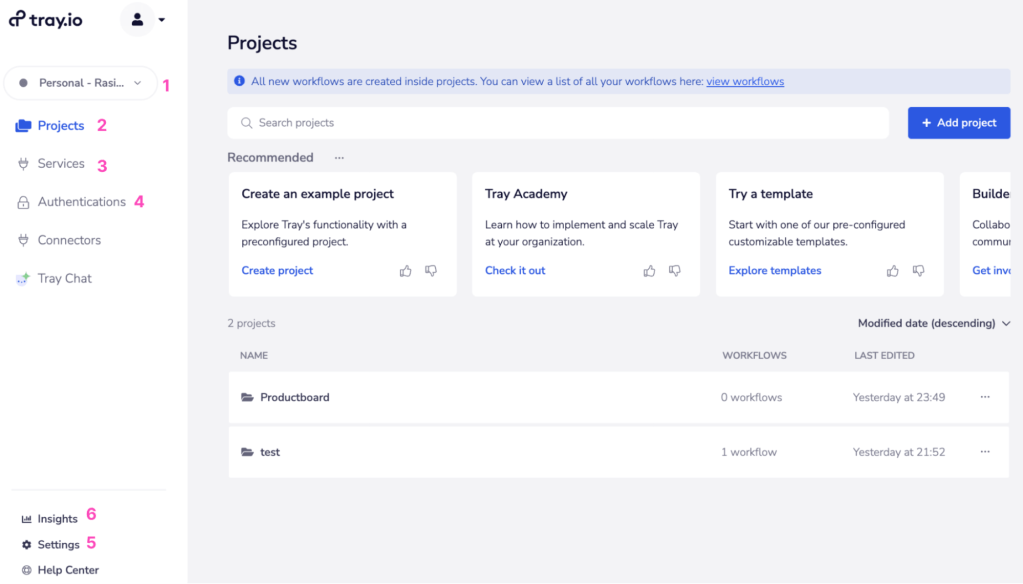
However, things are often more difficult in practice.
Since integrating an additional app into the existing stack is complicated, time-consuming, and difficult, many companies struggle with integration.
Unfortunately, this leads to lackluster performance, errors, and low functionality across the board. Many enterprises see the Tray.io integration platform as a go-to solution for complex integration.
Pros of using Tray.io
- It can connect to any software on the internet which has an API. The platform allows different systems to exchange functionality and data and work together seamlessly. Tray.io can be integrated with online services, databases, and platforms that manipulate data, perform actions, and automate processes.
- Extensive flexibility for embedding in larger and more complex applications. You can build multi-directional workflows and loop through them, which tech-savvy users can take advantage of.
- Option to embed your product and offer automation to your customers. For example, if you have a scheduling or event tool, you can integrate systems like Calendly and embed it into your solution within Tray.io’s platform. Whenever users type their login details to sign into your product, the platform automatically connects their Calendly data.
- First-class support. Consistent customer support reviews across Capterra, G2, TrustRadius, and Gartner.
Tray.io integration overview
The Tray Platform has well over 500 connectors that include data warehouses, CRMs, marketing automation platforms, team communication, Jira connectors, and more.
They effectively bridge the gaps between different apps and services, allowing them to exchange data and work together seamlessly. Connectors have basic CRUD (Create, Read, Update, and Delete) operations and event-based triggers.
However, since users always use more apps than there are connections available, Tray.io has enabled integration via universal connectors which can:
- Enable users to make API requests to any URL using other APIs manually.
- Access data for services without developed connectors using webhook triggers.
- Manipulate and transform data from a database or a flat file using the CSV Editor or JDBC connector.
Tray.io has put in the work to build a collection of powerful multi-directional connectors that make integration with any other API possible.
Tray.io pricing and costs
Tray’s pricing is undisclosed. However, there are three available tiers:
- Pro; a tier used for teams to complete specific critical assignments. The tier has 250k starter task credits, works for three different workspaces, and comes with a 7-day log retention.
- Team; the best tier instance for running multiple use cases within an environment. The tier has a 500k starter task credit, works for 20 workspaces, and has all add-ons available.
- Enterprise; is best used for multiple departments, allowing for customer and partner integrations. It has 750k starter task credits, includes all add-ons, and has access to the Embedded Bundle. For instance, you can use the Embedded Bundle if your solution features a range of integrations between several third-party services. You want to enable your End Users to authenticate themselves with each service involved or configure data.
According to Vendr, businesses with around 200 employees anticipate annual spending between $20,800 and $33,700. Companies with a headcount of 1000 employees expect annual costs between $28,200 to $49,300. Organizations with over 1000 employees expect annual spending between $29,900 and $66,000.
Tray.io limitations
- It takes time to set up and learn to use. According to 2024 TrustRadius Insights, much of Tray’s documentation is outdated, which makes things harder when climbing the steep learning curve.
- It is not as suitable for smaller companies with limited staff. Tray.io is best utilized by enterprises with complex integration challenges, which justifies its pricing. But if you’re a smaller company or a startup with fewer integration demands, you’re less likely to have the resources to commit to the platform.
- No free tier is available. Tray.io offers a 14-day free trial, where users are given onboarding materials and support. However, this is not enough time to properly familiarize with the environment. Also, after the trial ends, users need to pay for the service to gain access to their project.
How to choose the best Tray.io alternative
There are several key factors to weigh in when evaluating the best Tray.io alternative:
Evaluate if your current data automation processes are established and mature
Becoming a data-focused organization isn’t the same as flipping a switch. Understanding how mature your organization’s approach to data-processing and reporting is necessary before opting for a more sophisticated solution that offers enterprise-wide complexity. For instance, if an organization already tracks data and reports through spreadsheets, the ideal integration platform will support automated reporting and pull directly into spreadsheets so that the platform becomes a natural extension of established practices instead of a whole new process.
Consider all the resources you need before you adopt a new platform
Aside from budget, companies will have to dedicate man-hours to master using the new functionalities. If the stakeholders are already stretched thin, the solution should be less demanding and have no code.
What is the necessary depth of integration for your tech environment?
The common denominator of most negative reviews on sites like G2 or Capterra for integration platforms is poor functionality and bugs. Vendors that have more connectors and offer deeper integration are usually more expensive but worth it. Signing up for a solution and then not being able to automate reporting from core sources costs time and money. Before picking a Tray.io alternative, you should list all the data sources and make sure their integration is standard practice for an integration platform candidate.
How much support will you have during change management?
Adding another tool to your existing tech stack, even for the sake of consolidation, is a challenge. Regardless of your staff’s proficiency with setting up workflows and automation, stakeholders need onboarding and support. The quality of customer support and speed of resolving issues will have a major impact on building a successful use case.
Which Tray.io alternative is the best one for you?
It’s never easy to pick a rock-solid integration platform for your business, especially since there are so many vendors to choose from. While some providers excel at specific features, others might not be the best fit. Hopefully, this article made your choice easier.
Companies that want to succeed today need to make data-driven decisions every day. Without automated reporting that pulls data directly from core apps, that’s hardly possible. This is what makes robust analytics platforms like Coupler.io an excellent choice. Users can extract data from the 50+ most popular tools and deliver ready-to-use insights every day. If you need a great alternative to Tray.io, look no further than Coupler.io
Automate data export with Coupler.io
Get started for free



